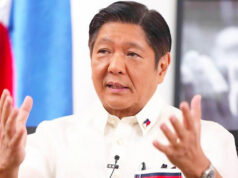Duterte fires two Palace employees for corruption
PRESIDENT Rodrigo R. Duterte on Thursday said that he has fired two Palace’s officials over alleged corruption.
The chief executive made the announcement during his speech in the opening ceremony of Agrilink, Foodlink, and Aqualink 2017.
“I promised you corruption, I will stop it. I will stop it. I just fired two employees from Malacañang,” he said. “Either you really stay clean, or you have to have clean… no corruption ako diyan,” he added.
Mr. Duterte has fired several government officials due to engaging in corruption.
Last March, Mr. Duterte had fired National Irrigation Administation (NIA) Head Peter T. Lavina for an alleged corruption. Lavina served as the presidential campaign spokesman of Mr. Duterte during the campaign period in 2016.
Next was Local Government Secretary Ismael D. Sueno who was accused of purchasing trucks for his business while in office.
Last April, Undersecretary Maia Chiara Halmen Reina Valdez was fired by Mr. Duterte for overruling National Food Authority Administrator Jason Aquino’s decision to suspend rice importation.
Also in the list of dismissed government officials were Dangerous Drugs Board Chairman Benjamin P. Reyes and Sugar Regulatory Administration Chief Anna Rosario V. Paner.
The Palace has refused to identify the two employees who have been fired, saying “it is premature to release any names until concerned parties are properly informed.”
Mr. Duterte, upon assumption of office, promised to eradicate corruption and solve the problem of illegal drugs during his administration.
NEW ANTI-GRAFT BODY CREATED
Meanwhile, on Wednesday, Mr. Duterte signed Executive Order No. 43, creating the Presidential Anti-Corruption Commission.
However, its power is limited to the executive branch, according to Senate Minority Floor Leader Franklin M. Drilon.
The EO gives the President “power to discipline and remove public officials and employees, except those who are not otherwise subject to his disciplining authority as may be provided by the Constitution and existing laws.”
The EO also notes the “President’s plenary powers as head of government authorize him to conduct lifestyle checks and fact-finding inquiries on all public officials and employees, including those outside the executive department.”
Mr. Drilon said, in statement released on Friday, Oct. 6, that the intention of the EO is commendable as it would assist the President in conducting investigation against erring officials.
“However, the executive order cannot be extended outside the executive branch without violating the core principles of independence and checks and balances enshrined in the Constitution,” Mr. Drilon said.
The creation of EO came after Mr. Duterte threatened to organize a commission that would investigate Ombudsman Conchita Carpio-Morales whose office has been conducting an investigation on Mr. Duterte’s alleged hidden wealth.
“While the President may want a body to check on the Ombudsman, he created one that the Ombudsman needs exactly. It’s interesting to watch how this new partnership plays out,” Senator Panfilo M. Lacson said in a message to Senate reporters on Friday, Oct. 6.
Mr. Lacson added that he is currently crafting a bill to amend the Ombudsman law but with the creation of EO No. 43, he said that it may no longer be necessary.
“The way EO No. (43) is worded, the Presidential Anti-Corruption Commission will obviously have law enforcement but not prosecutorial powers so inevitably, they will have to refer to the Office of the Ombudsman all corruption cases that they will investigate. I’m not sure if it’s an irony that it is actually what the Ombudsman needs at present – a law enforcement arm that can develop cases, conduct entrapment operations, apply for search warrants and perform other related law enforcement functions,” Mr. Lacson said.
In 2001, the Presidential Anti-Graft Commission was created during the term of President Gloria Macapagal Arroyo until it was abolished by her predecessor, President Benigno S.C. Aquino III in 2010. — Rosemarie A. Zamora and Mario M. Banzon



